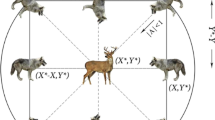Abstract
We study sensor scheduling problems of p-percent coverage in this paper and propose two scheduling algorithms to prolong network lifetime due to the fact that for some applications full coverage is not necessary and different subareas of the monitored area may have different coverage requirements. Centralized p-Percent Coverage Algorithm (CPCA) we proposed is a centralized algorithm which selects the least number of nodes to monitor p-percent of the monitored area. Distributed p-Percent Coverage Protocol (DPCP) we represented is a distributed algorithm which can determine a set of nodes in a distributed manner to cover p-percent of the monitored area. Both of the algorithms can guarantee network connectivity. The simulation results show that our algorithms can remarkably prolong network lifetime, have less than 5% un-required coverage for large networks, and employ nodes fairly for most cases.
Similar content being viewed by others
References
Cardei, M., Thai, M., Li, Y., Wu, W.: Energy-efficient target coverage in wireless sensor networks. INFOCOM 2005, 24th Annual Joint Conference of the IEEE Computer and Communications Societies. Proc. IEEE 3, 1976–1984 (2005)
Chen, J., Yu, F.: A location independent and coverage efficient protocol for wireless sensor networks. In: Integration Technology, 2007, ICIT ’07. IEEE International Conference, pp. 751–755, March 2007
Zhou, Z., Das, S., Gupta, H.: Connected k-coverage problem in sensor networks. In: Computer Communications and Networks, 2004, ICCCN 2004. Proceedings, 13th International Conference, pp. 373–378, October 2004
Berman, P., Calinescu, G., Shah, C., Zelikovsky, A.: Efficient energy management in sensor networks. In: Ad Hoc and Sensor Networks. Wireless Networks and Mobile Computing, vol. 2. Nova Science, New York (2005)
Gao, S., Vu, C., Li, Y.: Sensor scheduling for k-coverage in wireless sensor networks. In: 2nd International Conference on Mobile Ad-hoc and Sensor Networks (2006)
Huang, C.-F., Tseng, Y.-C.: The coverage problem in a wireless sensor network. In: WSNA’03: Proceedings of the 2nd ACM International Conference on Wireless Sensor Networks and Applications, pp. 115–121. ACM, New York (2003)
Wan, P.-J., Yi, C.-W.: Coverage by randomly deployed wireless sensor networks. IEEE/ACM Trans. Netw. 14(SI), 2658–2669 (2006)
Cheng, M., Ruan, L., Wu, W.: Achieving minimum coverage breach under bandwidth constraints in wireless sensor networks. INFOCOM 2005. 24th Annual Joint Conference of the IEEE Computer and Communications Societies. Proc. IEEE 4, 2638–2645 (2005)
Wang, B., Chua, K.C., Srinvasan, V., Wang, W.: Sensor density for complete information coverage in wireless sensor networks. In: Proceedings of EWSN 2006, February 2006
Cardei, M., Wu, J.: Energy-efficient coverage problems in wireless ad-hoc sensor networks. Comput. Commun. J. 29(4), 413–420 (2006)
Xu, K., Hassanein, H., Takahara, G., Wang, Q.: Wsn04-2: Differential random deployment for sensing coverage in wireless sensor networks. In: Global Telecommunications Conference, 2006. GLOBECOM’06, pp. 1–5. IEEE, New York (2006)
Berman, P., Calinescu, G., Shah, C., Zelikovsky, A.: Efficient energy management in sensor networks. In: Xiao, Y.P.Y. (ed.) Ad Hoc and Sensor Networks. Wireless Networks and Mobile Computing, vol. 2. Nova Science, New York (2005)
Tan, H.: Maximizing network lifetime in energy-constrained wireless sensor network. In: IWCMC’06: Proceedings of the 2006 International Conference on Wireless Communications and Mobile Computing, pp. 1091–1096. ACM, New York (2006)
Wu, Y., Ai, C., Gao, Y.L.S.: p-percent coverage in wireless sensor networks. In: International Conference on Wireless Algorithms, Systems and Applications. WASA’08, October 2008
Polastre, J., Szewczyk, R., Culler, D.: Telos: enabling ultra-low power wireless research. In: IPSN’05: Proceedings of the 4th International Symposium on Information Processing in Sensor Networks, pp. 48. IEEE Press, Piscataway (2005)
Crossbow, Mica2 datasheet, http://www.xbow.com/Products/productdetails.aspx?sid=174 (accessed 21 December 2008)
Author information
Authors and Affiliations
Corresponding author
Rights and permissions
About this article
Cite this article
Li, Y., Ai, C., Cai, Z. et al. Sensor scheduling for p-percent coverage in wireless sensor networks. Cluster Comput 14, 27–40 (2011). https://doi.org/10.1007/s10586-009-0088-9
Received:
Accepted:
Published:
Issue Date:
DOI: https://doi.org/10.1007/s10586-009-0088-9




